13 Health Benefits of Natarajasana & How to Do It?
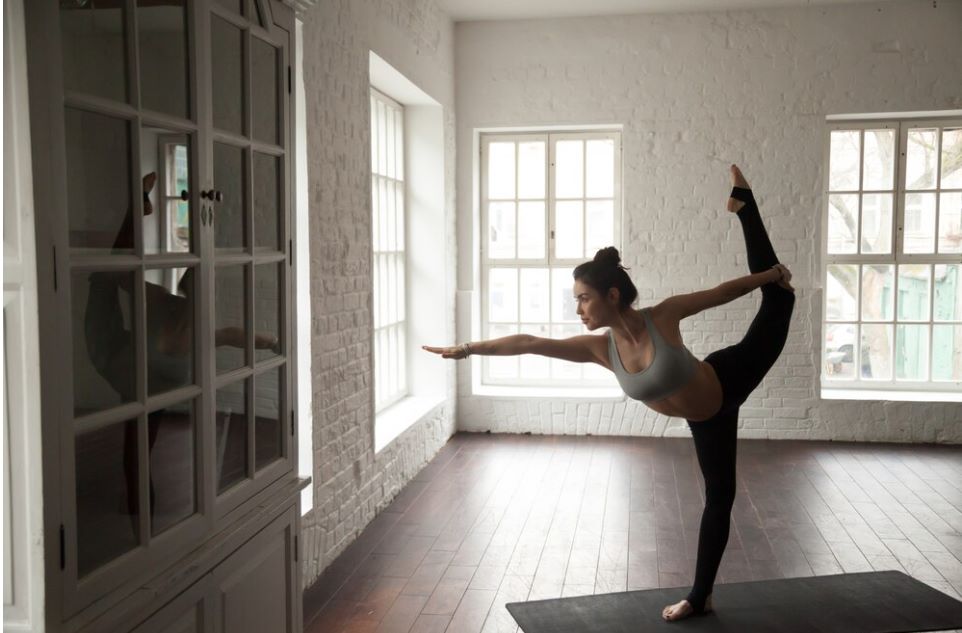
If you are someone who does not enjoy going to the gym but wants to build flexibility and improve strength, yoga is a good option for you. In this regard, you must have heard of Natarajasana or Lord of the Dance Pose.
It is derived from Bharatnatyam, a classical Indian dance form, and this pose is depicted in the Nataraja temple. If you are curious to know more about the health benefits of Natarajasana, keep reading.

Table of Contents

What is Natarajasana?
The qualities of Lord Shiva are strength, intensity, and equilibrium. Natrajasana replicates one of his most well-known dancing personas, Nataraj, which beautifully captures his love of dance, music, and expression.
The form is in harmony with this stance. Regularly performing this exercise helps strengthen your core, enhance body balance, promote flexibility, and increase overall physical strength. However, you must perform this yoga pose on an empty stomach or at least four hours after eating.
How to Perform Natarajasana?
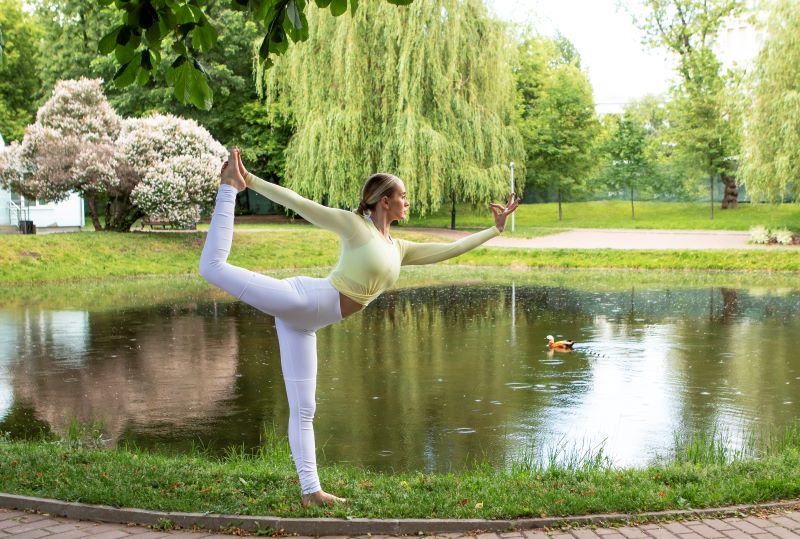
The following are the steps one needs to follow to perform Natarajasana:
Step 1: Start by forming the Mountain Pose (Tadasana), standing tall and distributing your weight evenly between both feet.
Step 2: Place more weight on your right foot. Bend your left knee to lift your left foot off the ground. Throughout this pose, keep your left knee near your midline.
Step 3: With your left hand, take hold of your left foot's instep. Your thumb should point towards your toes while resting on the bottom of your foot.
Step 4: Straighten out your right arm and reach the ceiling.
Step 5: As a counterbalance, raise your left leg behind you and lean forward. Always remember not to let your left knee splay to the side. You will also extend your right arm.
Step 6: Powerfully kick your left foot into your left hand to elevate the leg higher and deepen the backbend. Keep moving your left toes.
Step 7: To maintain your balance, fix your sight (Drishti) on anything stationary.
Step 8: Stay in this position for 5 to 10 breaths.
Step 9: Keep kicking your left foot into your left hand to get back up. Your left leg should now be parallel to your right. Now repeat the same on the opposite side.
13 Health Benefits of Natarajasana
Natarajasana is a dynamic yoga posture that combines strength, flexibility, and balance. This graceful pose, inspired by the Hindu deity Shiva's cosmic dance, offers numerous health benefits for the body, mind, and spirit, such as:
1. Enhances Memory and Mental Health
Natarajasana challenges the mind-body connection, requiring focus and concentration to maintain balance. Regularly engaging in this pose can enhance memory, cognitive function, and overall mental health.
2. Strengthens the Knees
As you balance on one leg in Natarajasana, the knees are strengthened and stabilised. This can help prevent injuries and improve knee joint health, which is especially beneficial for individuals with weak or injured knees.
3. Improves Body Balance
Natarajasana improves body balance by challenging stability and coordination. By practising this pose, you can enhance proprioception and spatial awareness, leading to better balance and coordination in daily activities.
4. Helps Reduce Stress
The mindful movement and deep breathing in Natarajasana help reduce stress and promote relaxation. This pose can alleviate stress and anxiety by releasing tension and calming the nervous system, fostering a sense of peace and calm.
5. Reduces Obesity
Regular practice of Natarajasana can aid in weight management and reduce obesity. This dynamic pose engages multiple muscle groups, burns calories, and promotes metabolic function, contributing to weight loss and overall fitness.
6. Strengthens Lower Body Muscles
This pose strengthens the muscles of the legs, ankles, and feet as they work to support the body's weight. The quadriceps, hamstrings, glutes, and calf muscles are engaged in the pose, helping to build strength and endurance in these areas.
7. Increases Flexibility
Natarajasana stretches the shoulders, chest, thighs, groynes, and abdomen, promoting flexibility and mobility. Regular practice of this pose can help release tension and tightness in these areas, improving overall flexibility.
8. Enhances Focus and Concentration
Balancing in Natarajasana requires focus and concentration to maintain stability and alignment. By bringing your attention to the present moment and focusing on your breath, you can cultivate mental clarity and presence, enhancing overall focus and concentration.
9. Stimulates Digestion
The twisting action in Natarajasana stimulates digestion and massages the abdominal organs, promoting healthy digestion and elimination. This can help alleviate digestive issues such as bloating, gas, and constipation.
10. Relieves Anxiety
The deep breathing and mindful movement in Natarajasana can help calm the nervous system and reduce anxiety. By connecting with your breath and allowing your body to relax into the pose, you can experience a sense of peace.
11. Opens the Heart Centre
Natarajasana opens the heart centre, stretching the chest and shoulders and promoting emotional well-being. This can help release tension and negativity, allowing you to experience greater compassion and connection with yourself.
12. Improves Posture
Natarajasana elongates the spine and strengthens the muscles of the back, improving posture and alignment. By standing tall and lifting through the chest, you can counteract the effects of slouching and hunching, promoting better spinal health.
13. Energises the Body
Natarajasana increases circulation and oxygen flow throughout the body, energising the body and uplifting the mood. This can help alleviate feelings of fatigue and lethargy, leaving you feeling invigorated and revitalised after practice.
The Mudras of Natarajasana
The mudras of Natarajasana, or Lord of the Dance Pose, enhance the practice by incorporating hand gestures that deepen the connection between mind, body, and spirit. Each of the following mudra holds its own significance and benefits, contributing to a holistic experience of this dynamic yoga posture:
1. Damaru Hasta Mudra (Drum Hand Gesture)
Damaru Hasta Mudra is formed by joining the tips of the thumb and the little finger while extending the other fingers. This mudra represents the shape of a traditional Indian drum (damaru) and symbolises rhythm, creativity, and divine energy.
Benefits of Damaru Hasta Mudra: Damaru Hasta Mudra activates the Sacral Chakra, one of the seven chakras, stimulating creativity and passion. It also enhances focus and concentration, promoting mental clarity and productivity.
2. Gyan Mudra (Knowledge Gesture)
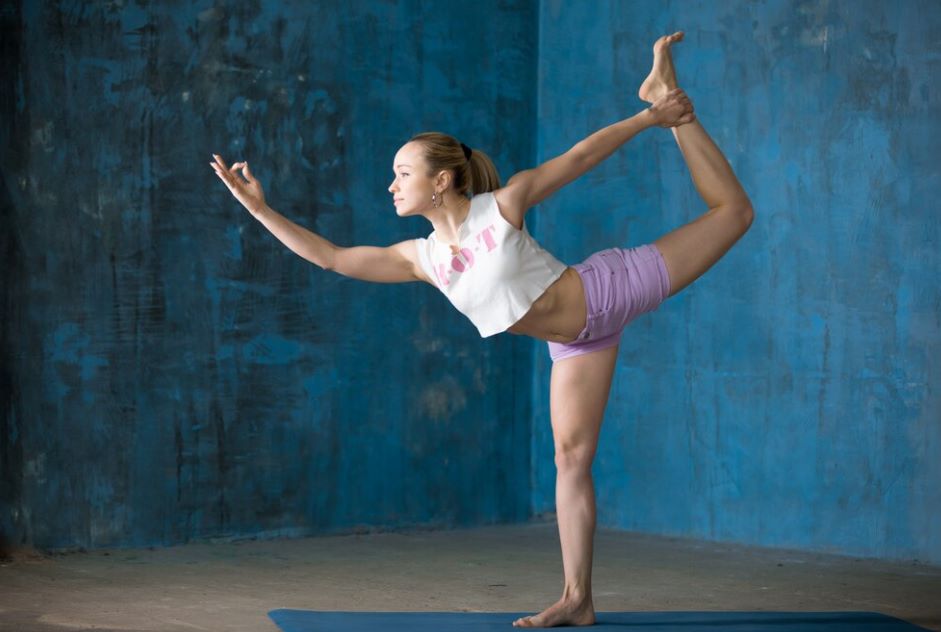
Gyan Mudra is created by touching the tip of the index finger to the tip of the thumb while the other three fingers remain extended. This mudra symbolises knowledge and wisdom, facilitating mental clarity and insight.
Benefits of Gyan Mudra: Gyan Mudra stimulates the brain and enhances concentration, making it ideal for meditation and spiritual practices. It also alleviates stress and anxiety, promoting a sense of calm and balance.
3. Bio Mudra (Life Gesture)
Bio Mudra is formed by curling the fingers into the palms and pressing the thumbs against the index fingers, creating a fist-like shape with the hands. This mudra represents the vitality and life force energy within the body.
Benefits of Bio Mudra: Bio Mudra increases energy levels and revitalises the body, promoting overall health and well-being. It also improves circulation and detoxification, enhancing vitality and immune function.
Types of Natarajasana
Natarajasana can be practised in several variations, each offering unique challenges and benefits. Some common types of Natarajasana variations include:
1. Standing Quad Stretch
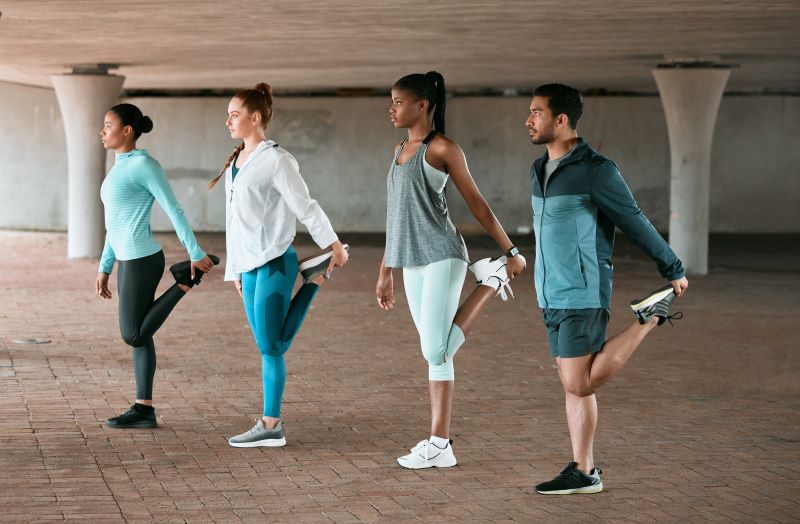
This variation involves standing on one leg while reaching back to hold the opposite foot, stretching the quadriceps. Maintain balance and gently press the foot towards the buttocks to deepen the stretch. It enhances flexibility and balance.
2. Dancer Pose with Chair

Using a chair for support, lift one leg behind and reach back to hold the ankle or foot. The chair aids balance, allowing for stability and support during the pose. This variation is ideal for those needing assistance with balance.
3. Bowing Lord of the Dance Pose
Perform Natarajasana and then hinge at the hips, lowering the torso towards the ground. Aim to bring the torso parallel to the ground, creating a bow-like shape. It provides a deep stretch for the front body and strengthens the back muscles.
4. Prone Dancer Pose
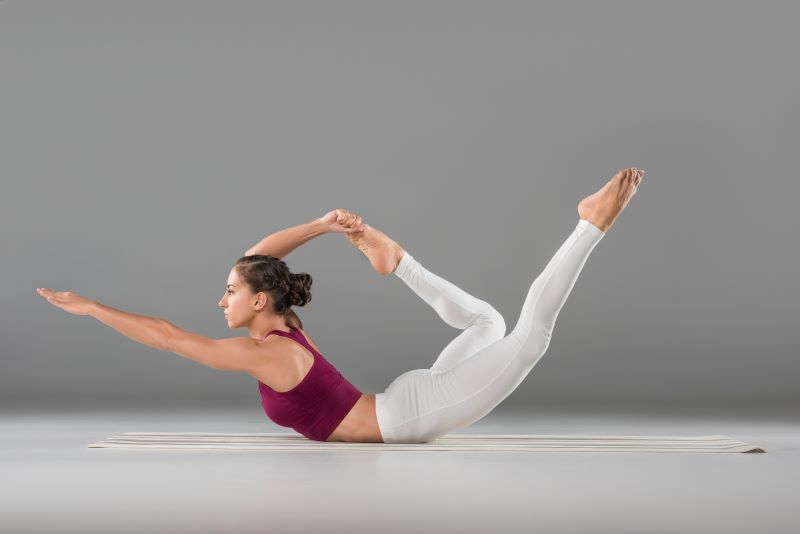
Begin by lying face down and reach back to hold the ankles or feet. Lift the chest and legs off the ground, engaging the back muscles for a deep backbend. This variation strengthens the back, opens the chest, and improves spinal flexibility.
Things to Know Before Doing Natarajasana Yoga
Before delving into the elegant and dynamic practice of Natarajasana, it's essential to consider various factors to ensure a safe and fulfilling yoga experience. Here's what you need to know before attempting Natarajasana:
- Flexibility and Warm-Up: To adequately prepare the body, prioritise dynamic stretches and yoga poses targeting the quadriceps, hips, and shoulders.
- Strength and Stability: Integrate strengthening exercises and core work to build muscular support for balance and stability.
- Alignment and Modifications: Pay close attention to alignment cues and utilise props to support proper form and reduce the risk of injury.
- Mindfulness and Breath Awareness: Cultivate mindfulness and focus on steady, controlled breathing to calm the mind and enhance concentration.
- Patience and Progression: Approach your practice with patience. Start with modified variations and increase intensity as you become more comfortable.
- Quiet Space: To facilitate focus and concentration during your yoga practice, choose a calm and peaceful environment free from distractions.
- Proper Equipment: Ensure you have appropriate yoga attire and props, such as blocks or straps, to support your practice.
- Hydration and Nutrition: Drink water before and after your practice to stay hydrated, and consider eating a light meal or snack to fuel your body
How Long to Hold Natarajasana Pose?
Determining how long to hold Natarajasana requires consideration of various factors. Here's a guide to help you choose the appropriate duration for sitting in Natarajasana based on your skill level:
- Beginner Practitioners: It's recommended that beginners start with shorter holds of about 20-60 seconds on each side. This allows beginners to focus on finding balance and maintaining proper alignment without overexerting themselves.
- Advanced Practitioners: Advanced practitioners, with greater strength and flexibility, may hold Natarajasana for 2-3 minutes on each side. Holding for an extended duration challenges advanced practitioners to explore variations.
Remember that the time spent in Natarajasana can vary depending on flexibility, strength, and comfort. You must approach the pose with mindfulness, patience, and a deep respect for your body's capabilities and limitations.
Risks of Overdoing Natarajasana
While Natarajasana offers numerous benefits, being aware of the risks associated with overdoing the pose is essential. Here are some risks to be mindful of:
- Muscle and Joint Strain: Overstretching in Natarajasana can strain the muscles and joints, particularly in the quadriceps, hips, knees, and shoulders. This can lead to soreness, inflammation, and potential injury if not performed with proper alignment and control.
- Imbalance and Instability: Attempting to hold Natarajasana excessively without adequate strength and stability can result in imbalance and instability. This increases the risk of falling or losing control of the pose, potentially causing injury.
- Joint Compression: Overdoing Natarajasana may cause excessive compression of the knee and ankle joints, especially if the pose is held with improper alignment or excessive force. Prolonged compression can lead to joint discomfort and inflammation.
- Lower Back Strain: Overexertion in Natarajasana's backbend can strain the muscles of the lower back, leading to discomfort and potential injury to the lumbar spine. This risk increases if the pose is held for an extended period or performed with poor alignment.
- Fatigue: Overdoing Natarajasana can result in fatigue, especially if combined with other strenuous yoga poses. This may lead to exhaustion, decreased performance, and increased risk of injury during subsequent activities.
To minimise these risks, practice Natarajasana mindfully, with proper alignment, control, and awareness of your body's limits.
Important Tips for Practising Natarajasana
As a beginner, you might find it difficult to perform Natarajasana with ease. So here are some tips for you:
Never perform this yoga pose without the supervision of a qualified instructor because it is an intermediate asana. To learn how to execute this pose, seek yoga classes in your area.
By utilising a chair or a strap as a prop, beginners, the elderly, and even those struggling initially with this pose can alter it. The quadriceps stretch while using a wall as support is another useful variant of this pose.
When performing Natarajasana, never overstretch, hyperextend, or lock your muscles or limbs, as it can lead to various injuries.
What are the Precautions and Contraindications of Natarajasana?
Here are some safety precautions and contraindications you should consider before performing Natarajasana:
If you have a back or ankle ailment, stay away from Natarajasana.
Avoid doing this pose until your wound has fully healed if you recently had surgery.
Never perform Natarajasana without first warming up. Since this pose involves a full-body stretch, your muscles should be warmed up before beginning.
Start off cautiously. Never begin with too many repeats.
Always perform Natarajasana in a clean and well-ventilated spot. Turn off the TV and your phone to prevent distraction.
Stop doing Natarajasana immediately if you experience any pain or a strong pull.
If you are experiencing tension or anxiety, refrain from performing this asana. Your body may get overheated as a result, which could give you palpitations or irritability.
Stay away from this asana if you have a fever, flu, or a cold.
Who Should Avoid Doing Natarajasana?
Specific individuals should approach Natarajasana with caution or avoid it altogether. These include:
- Recent Injuries: Individuals with recent injuries to the legs, knees, hips, or shoulders should avoid Natarajasana, as the pose may exacerbate existing discomfort or delay the healing process.
- Chronic Pain: Those experiencing chronic pain or discomfort in the lower back, knees, or ankles should refrain from practising Natarajasana, as the pose involves significant stretching and balancing on one leg.
- Balance Issues: Individuals with balance issues or vertigo should avoid Natarajasana, as the pose requires a strong sense of equilibrium and stability to maintain proper form and prevent falls.
- Pregnancy: Pregnant individuals should avoid Natarajasana, particularly in the later stages of pregnancy, as the pose involves deep back bending and balancing on one leg, which could strain the abdominal muscles and increase the risk of injury.
- High Blood Pressure: Individuals with uncontrolled high blood pressure should avoid Natarajasana, as the pose can elevate heart rate and blood pressure, potentially leading to dizziness or fainting.
- Recent Surgery: Those who have undergone recent surgery, particularly on the legs, knees, hips, or shoulders, should refrain from practising Natarajasana until they have fully recovered and received clearance from their healthcare provider.
- Spinal Issues: Individuals with spinal issues such as herniated discs, spinal stenosis, or spondylolisthesis should avoid Natarajasana, as the deep backbend involved in the pose may exacerbate these conditions.
What are the Easy Modifications of Natarajasana?
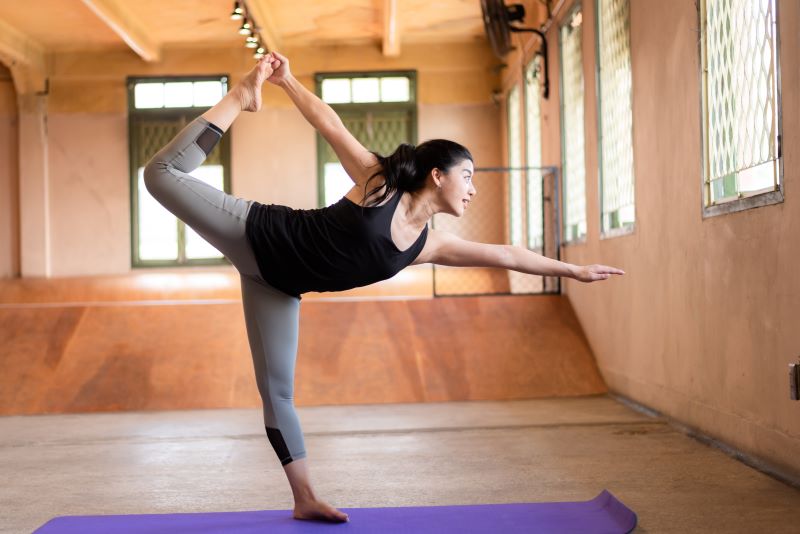
The first level of this posture, which is a detailed elevation of the leg by holding it from behind with your arms, is what someone who wishes to master this pose should focus on. Several adjustments that can be made to simplify the posture are listed below:
The ideal approach to go further into the pose is to use a wall for balance. You can also use a partner to assist you and help you maintain a steady balance.
If the lower back and arms aren't flexible enough to raise the legs high enough, you might use a yoga strap to wrap it around the ankle and pull the leg toward you by pulling the strap higher. But be careful to do this under the supervision of an instructor.
If the hips aren't flexible enough, you can begin the practice by bringing your foot to your elbow, twisting your lower back slightly, and then raising the leg that's supporting it within this elbow. By practising to stay in this position for a few breaths, you'll gain more confidence in your ability to twist your hips fully.
One could lean the bent shin against the wall to improve stretch and hold on to the toes before entering the position.
So, as you see, Natarajasana has multiple benefits, and doing it regularly can improve your body's flexibility and strength. In addition, knowing the steps to perform it and the precautions you should take before doing it will help you perform it effortlessly.










